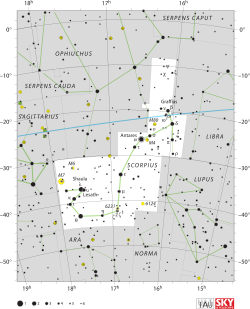Kappa Scorpii
| Observation data Epoch J2000 Equinox J2000 |
|
|---|---|
| Constellation | Scorpius |
| Right ascension | 17h 42m 29.27520s |
| Declination | –39° 01′ 47.9391″ |
| Apparent magnitude (V) | 2.39 |
| Characteristics | |
| Spectral type | B1.5 III |
| U−B color index | -0.914 |
| B−V color index | -0.228 |
| Variable type | β Cephei |
| Astrometry | |
| Radial velocity (Rv) | –14.0 km/s |
| Proper motion (μ) |
RA: -6.05 mas/yr Dec.: -25.54 mas/yr |
| Parallax (π) | 6.75 ± 0.17mas |
| Distance | 480 ± 10 ly (148 ± 4 pc) |
| Orbit | |
| Period (P) | 195.65 days |
| Eccentricity (e) | 0.488 ± 0.005 |
| Periastron epoch (T) | 92.7 ± 0.5 |
|
Semi-amplitude (K1) (primary) |
48.0 ± 0.3 km/s |
| Details | |
| κ Sco A | |
| Mass | 17 M☉ |
| Radius | 6.8 R☉ |
| Surface gravity (log g) | 4.01 cgs |
| Temperature | 23,400 K |
| Rotation | 1.90 days |
| Rotational velocity (v sin i) | 105 km/s |
| Age | 25.1 ± 1.3 Myr |
| κ Sco B | |
| Mass | 12 M☉ |
| Radius | 5.8 R☉ |
| Surface gravity (log g) | 4.00 cgs |
| Temperature | 18,800 K |
| Other designations | |
| Database references | |
| SIMBAD | data |
Kappa Scorpii (κ Sco, κ Scorpii) is a binary star system in the southern constellation of Scorpius. It has the traditional name Girtab, which is the Sumerian word for 'scorpion' and has survived through the Babylonian star catalogues. The name Girtab is actually (or perhaps originally) applied to an asterism comprising this star, Lambda Scorpii, Upsilon Scorpii, and Iota Scorpii. With an apparent visual magnitude of 2.4, this star system is readily visible to the naked eye. Parallax measurements place it at an estimated distance of roughly 480 light-years (150 parsecs) from the Earth.
This is a spectroscopic binary, which is a type of binary star system in which the two stars are so close together that they have not been individually resolved with a telescope. The pair orbit each other with a period of about 196 days and an eccentricity of nearly 0.5. The combined spectrum of this pair matches a star with a stellar classification of B1.5 III. The 'III' luminosity class indicates the presence of a giant star that has exhausted the supply of hydrogen at its core and is in a late evolutionary stage.
The primary component of the pair, κ Sco A, is a variable star of Beta Cephei type. It is undergoing radial pulsations with a dominant frequency of 4.99922 cycles per day, or 4.8 hours per cycle. There are overlapping secondary pulsation frequencies of about 4.85 and 5.69 cycles per day. This star has about 17 times the mass of the Sun and is nearly 7 times the Sun's radius. The effective temperature of the outer envelope is 23,400 K, giving it a blue-white hue. It is rotating rapidly, with an estimated period of only 1.9 days and an axis of rotation that is inclined by about 40° to the line of sight from the Earth.
...
Wikipedia

